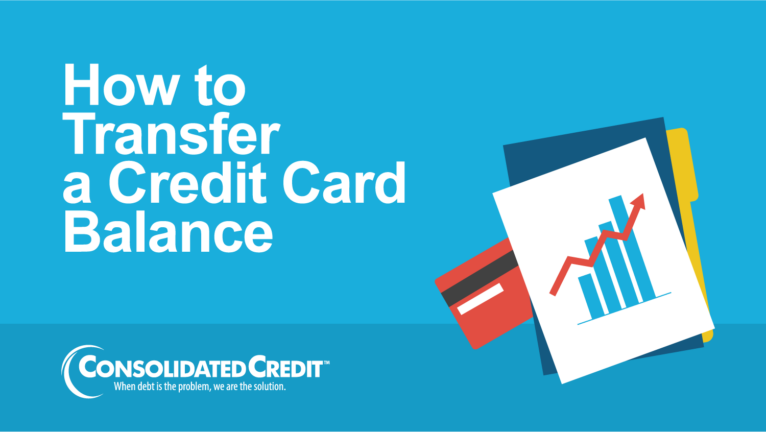How to do a Balance Transfer
A balance transfer is a popular option for DIY debt relief. It involves paying off debt from other pre-existing accounts and putting it onto a credit card.
It works virtually the same way a debt consolidation loan does; the balance of one or more pre-existing accounts is paid off by borrowing that exact amount from another source. Doing so can yield meaningful savings if the new loan has a lower interest rate than the pre-existing accounts.
Balance transfer vs. Debt consolidation loan

The primary difference between a balance transfer and a debt consolidation loan is that you’re either paying off pre-existing debts using a revolving line of credit (a credit card) or a fixed line of credit (a loan). A few benefits of using a balance transfer over a debt consolidation loan:
- Many balance transfer credit cards have promotional introduction rates. Some offer as little as 0% interest for up to two years
- A revolving line of credit can continue being used long after the initial transferred balances have been paid — building up your credit
However, there are also some limitations to balance transfers:
- The amount of debt that can be transferred is limited to the credit card’s credit limit which makes it less ideal for tackling substantial debt
- Eligibility for this option is based on your credit score
But balance transfers are just one of several debt relief methods — how do you know if it’s your best option for getting rid of debt?
Is a balance transfer right for me?
Here are some questions to ask yourself when trying to decide if a balance transfer is a good idea:
- Is the balance I want to transfer less than $5,000?
- Is my credit score Good or better?
- Can I afford to pay off the entire balance by the end of a promotional APR period?
If you answered “yes” to these questions, a balance transfer might be your best option
Talk to a certified credit counselor to see if a balance transfer is right for you.
A balance transfer is a popular option for DIY debt relief. It involves paying off debt from other pre-existing accounts and putting it onto a credit card. It works virtually the same way a debt consolidation loan does; the balance of one or more pre-existing accounts is paid off by borrowing that exact amount from another source. Doing so can yield meaningful savings if the new loan has a lower interest rate than the pre-existing accounts.
The primary difference between a balance transfer and a debt consolidation loan is that you’re either paying off pre-existing debts using a revolving line of credit (a credit card) or a fixed line of credit (a loan). A few benefits of using a balance transfer over a debt consolidation loan:
- Many balance transfer credit cards have promotional introduction rates. Some offer as little as 0% interest for up to two years
- A revolving line of credit can continue being used long after the initial transferred balances have been paid — building up your credit
However, there are also some limitations to balance transfers:
- The amount of debt that can be transferred is limited to the credit card’s credit limit which makes it less ideal for tackling substantial debt
- Eligibility for this option is based on your credit score
But balance transfers are just one of several debt relief methods — how do you know if it’s your best option for getting rid of debt?
Is a balance transfer right for me?
Here are some questions to ask yourself when trying to decide if a balance transfer is a good idea:
- Is the balance I want to transfer less than $5,000?
- Is my credit score Good or better?
- Can I afford to pay off the entire balance by the end of a promotional APR period?
If you answered “yes” to these questions, a balance transfer might be your best option
Talk to a certified credit counselor to see if a balance transfer is right for you.
How to do a balance transfer: Step-by-step guide
Step 1: Assess your debt
The amount of debt that can be paid off with a balance transfer credit is determined by the credit limit, a potential limitation that makes it important to prioritize which existing account balances to pay off — likely the ones with the highest interest rates. Incorporating your monthly debt payments into your budget is especially important since the last thing you want to do when paying off a balance transfer card is rack up more debt on other credit cards.
Use Consolidated Credit’s Debt Worksheet to see where you stand »
Step 2: Choose a balance transfer card
Once you have all your financial ducks in a row and know which balances you want to include in the balance transfer, it’s time to choose the specific balance transfer card you’ll use. Look for cards with a promotional low or 0% APR. These promotional interest rates can range from six months up to 22 months. The longer the promotional period, the longer you’ll be able to pay down debt interest-free.
Note: some credit furnishers don’t allow transfers from their accounts to balance transfer credit cards they issue. Example: If you owe Chase Banks $1,000 on Credit Card A, they won’t let you transfer that balance to your new balance transfer card, Credit Card B.
Step 3: Transfer your balances to the new card
Once your application is accepted, it’s time to initiate the balance transfer. This process can vary depending on the credit card issuer. In many cases, you’ll be asked if you’re interested in a balance transfer immediately after being approved for the card. It’s possible to initiate a balance transfer after declining of this initial offer, but make sure that any promotional offers would still apply.
Once initiated, you’ll be prompted to enter the amounts and the account details for the balances you’d like to be paid off. Credit issuers typically send these funds directly to the owners of your other accounts so you don’t have to deal with the hassle of transferring funds yourself. This process can take several weeks so you may still need to make a payment on these accounts to keep them in good standing.
Most companies charge a fee for balance transfers, which is usually 3-5% of the total balance or a flat rate of $5-10, whichever is greater. Some balance transfer offers may include waiving this fee, another great perk to look out for.
Step 4: Pay off your debt on the balance transfer card.
Once the promotional APR period of your balance transfer card ends, the regular APR will apply, which averages in the 20% range. That’s really expensive! The best way to use a balance transfer card is to do so with the intention of paying off the entire transferred balance by the time the intro APR period ends.
To calculate how much your monthly payments should be, divide the total balance amount by the number of months of the promotional period. Build these monthly payments into your budget, making whatever adjustments you need to keep your budget balanced. Avoid falling behind on payments by setting up an automatic payment plan.
5 tips for transferring balances successfully to consolidate debt
A balance transfer credit card is a great tool to get rid of pesky debt — but use it in the wrong financial circumstances you can quickly make your debt problems worse. With that in mind, make sure that you understand these five points before you decide to apply for a balance transfer credit card.
Tip No. 1: Always aim for 0% APR
One of the main goals for debt consolidation is to reduce the interest rate applied to your debt as much as possible. This allows you to pay off the debt you owe (principal), rather than most of your payments going to pay off accrued monthly interest charges.
The big advantage of using a balance transfer credit card for debt consolidation is that you can qualify for 0% APR for an introductory period with a good credit score — something that consolidation loans don’t offer. This means 100% of every payment you make goes to eliminating the principal so you can eliminate the debt quickly.
If you can’t qualify for 0% APR because you don’t have strong enough credit you will usually be better off using a different option for consolidation.
Tip No. 2: The longer the introductory period, the better
Your goal with a balance transfer consolidation strategy is to eliminate the debt in full before the introductory period expires. This means you want to aim for the longest introductory period possible, so you have more months to eliminate the debt before the standard interest rate goes into effect.
Keep in mind that the shorter your introductory period, the higher the payments will have to be to accomplish Tip No. 3 below!
Tip No. 3: Divide the debt by the number of months at 0% APR
As mentioned above, your goal when you consolidate with a balance transfer is to pay off all of the debt within the introductory period before the 0% APR period expires. Once it does, the interest rate can jump to 20% or higher. In other words, you effectively lose the benefit of the balance transfer once the standard interest rate applies.
With that in mind, if you have $5,000 in debt to pay off in an 18-month introductory period, your payments should be $278 per month – regardless of what the minimum payment requirement says. This is why balance transfers only have limited viability as a consolidation solution. If you have too much debt, such as $25,000, your monthly payments would have to be $1,389 to pay off your debt before the introductory period expires. In most cases, that would be too high for your budget, so you’d be better off with a different debt solution.
Tip No. 4: Be careful with balance transfer fees
Almost all balance transfer cards have a fee applied for each balance you transfer. Depending on which balance transfer credit card you choose, this can range from 3 to 5% of each balance transferred. Minimum fees are usually between $5 and $10. This means fees have the potential to significantly increase the amount of debt you need to pay off.
If you have a card with a transfer fee of 3% then the fees for that $5,000 balance would be around $150. That means your monthly payments would need to be around $286 instead of $278 to pay off the balance in full within the 18-month 0% APR promotional rate.
Tip No. 5: Stop spending on your other credit cards
One of the biggest mistakes people make in do-it-yourself debt consolidation is that they fail to stop spending on credit after they’ve consolidated. When you transfer the balances to the new card, your other accounts will be sitting at zero balances. It can be tempting to pull out the plastic to make a purchase you want or to earn rewards again.
However, you need to be committed to eliminating your debt rather than adding to it. Stop charging on your high interest credit cards until the consolidated debt has been eliminated. Otherwise, you can end up making your situation with debt worse instead of better.
Having trouble making a balance transfer work? Discover other options to get out of debt.
